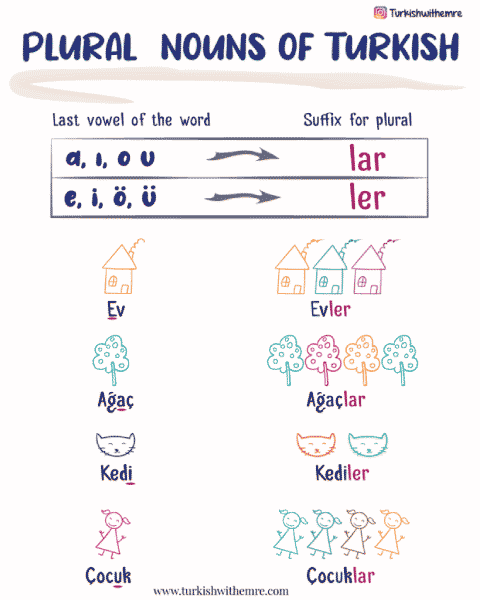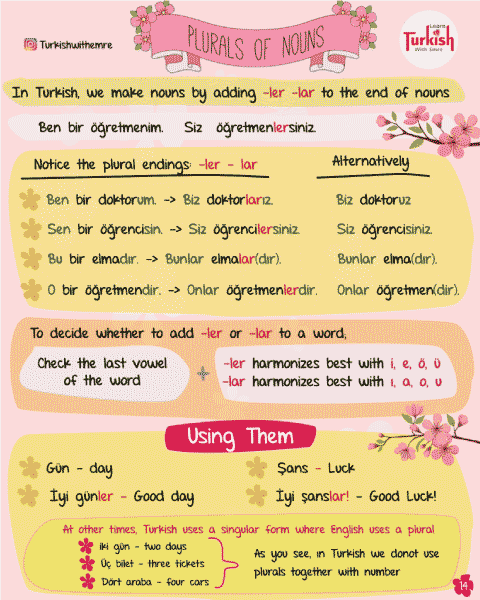Turkish Plural : Grammar rules and Exercises
In this post, we will learn all about the plural in Turkish language. At the end of the lesson, there is an exercise part for you to see how good you are at the Turkish plurals. If you have questions related, please share with us on the comment section.
Suffixes -ler / -lar
In Turkish language we make plural the nouns by adding -ler or -lar suffix to the end of the noun.
You will possibly ask how to decide -ler or -lar to make the plural the noun.
There is simple rule for that lets have a look at the below table firstly.
| Last vowel of the word | Suffix for Plural |
|---|---|
| a, ı, o, u | – lar |
| e, i, ö ü | – ler |
In the above table, you see the rule. If the Turkish noun’s last vowel ends with one of the e,i,ö,ü , we add suffix -ler to make the sentence plural.
If the Turkish noun’s last vowel ends with one of the a,ı,o,u , we add suffix -lar to make the sentence plural .
Lets have a look at he below examples.
TURKISH PLURAL EXAMPLES
In the below table and poster , you will see how to make nouns plural in Turkish language with -ler and -lar suffixes. Check the last vowels of the word before you add the correct suffix.
TURKISH PLURALS IN THE SENTENCES
We know now how to make nouns plural in Turkish. Lets see how they are used in the sentences.
Sepette yumurtalar var.
There are eggs in the basket.
Domatesler taze.
Tomatoes are fresh
Kutular boş.
Boxes are empty.
Kitaplar masanın üzerinde.
The books are on the table.
Ellerim kirli.
My hands are dirty.
Meyveler çürük.
Fruits are rotten
Öğrenciler okulda.
Students are at school.
Arkadaşlarım bekliyor.
My friends are waiting.
IMPORTANT NOTES ABOUT TURKISH PLURAL
There is one point that ı must show you about plural in Turkish.
If we add numbers before the nouns, we don’t need to add plural suffixes to the noun. To explain it better , lets have a look at the below examples.
| İki elma | Two apples |
| Beş öğrenci | Five students |
| Üç arkadaş | Three friends |
| İki el | Two hands |
| Altı kitap | Six books |
| İki kutu | Two books |
| Üç yumurta | Three eggs |
As you see, unlike English, if you use numbers more than one before the noun, you don’t need add plural suffix to the noun.
Look at the below examples to see how to mentioned grammar rule is used in the sentence.
2 muz istiyorum.
I want two bananas
Üç arkadaş oturuyor.
Three friends are sitting.
Bana iki elma verdi.
She gave me two apples.
İki yumurta kırık.
Two eggs are broken.
Sometimes we use quantifiers in our sentences (Very, much, many, plenty etc. ). If you use Turkish quantifiers (Çok, fazla, bir sürü, bir çok, vb. ) in your sentences , we also don’t add plural suffix to the noun.
Lets have a look at the below examples to make it more clear for you.
Çok fazla çiçek var.
There are too many flowers.
Az elma var.
There are few apples.
Çok yanlış cevap var.
There are so many wrong answers.
Bir sürü kedi var.
There are a lot of cats.
In this section, we have seen the main differences of Plural in Turkish with English. Now time to test what you have learnt until now.
TURKISH PLURAL EXERCISES
I think we have learnt everything everything you need about plurals in Turkish language. Now it is time to practice the plural in Turkish. If you have any questions related with exercises or any other exercise, please share with us in the comment section below.
#1. Yumurta
#2. Domates
#3. kutu
#4. kitap
#5. meyve
#6. öğrenci
#7. Arkadaş
#8. Diş
#9. Erkek
#10. Telefon
Results
There is a nice lesson about shopping in Turkish. You can use shopping products with plurals as well.
Learn how to greet your Turkish friends in Turkish language.
Vectors in this page created by freepik www.freepik.com






